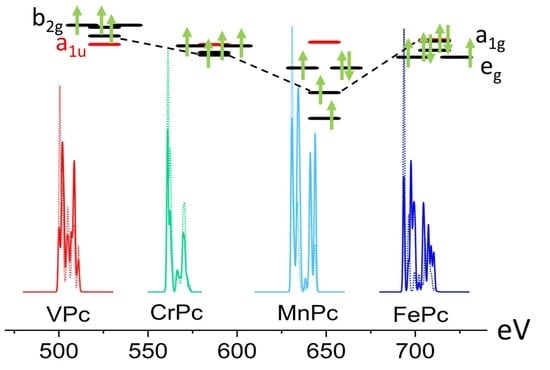A Theoretical Study of the Occupied and Unoccupied Electronic Structure of High- and Intermediate-Spin Transition Metal Phthalocyaninato (Pc) Complexes: VPc, CrPc, MnPc, and FePc
Abstract
Share and Cite
Carlotto, S.; Sambi, M.; Sedona, F.; Vittadini, A.; Casarin, M. A Theoretical Study of the Occupied and Unoccupied Electronic Structure of High- and Intermediate-Spin Transition Metal Phthalocyaninato (Pc) Complexes: VPc, CrPc, MnPc, and FePc. Nanomaterials 2021, 11, 54. https://doi.org/10.3390/nano11010054
Carlotto S, Sambi M, Sedona F, Vittadini A, Casarin M. A Theoretical Study of the Occupied and Unoccupied Electronic Structure of High- and Intermediate-Spin Transition Metal Phthalocyaninato (Pc) Complexes: VPc, CrPc, MnPc, and FePc. Nanomaterials. 2021; 11(1):54. https://doi.org/10.3390/nano11010054
Chicago/Turabian StyleCarlotto, Silvia, Mauro Sambi, Francesco Sedona, Andrea Vittadini, and Maurizio Casarin. 2021. "A Theoretical Study of the Occupied and Unoccupied Electronic Structure of High- and Intermediate-Spin Transition Metal Phthalocyaninato (Pc) Complexes: VPc, CrPc, MnPc, and FePc" Nanomaterials 11, no. 1: 54. https://doi.org/10.3390/nano11010054
APA StyleCarlotto, S., Sambi, M., Sedona, F., Vittadini, A., & Casarin, M. (2021). A Theoretical Study of the Occupied and Unoccupied Electronic Structure of High- and Intermediate-Spin Transition Metal Phthalocyaninato (Pc) Complexes: VPc, CrPc, MnPc, and FePc. Nanomaterials, 11(1), 54. https://doi.org/10.3390/nano11010054







